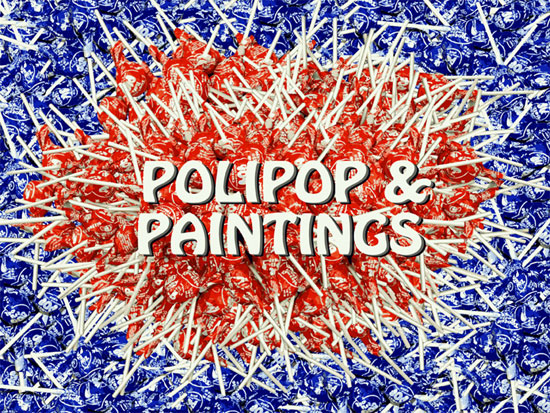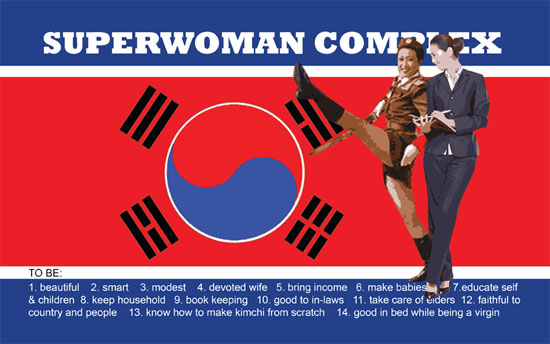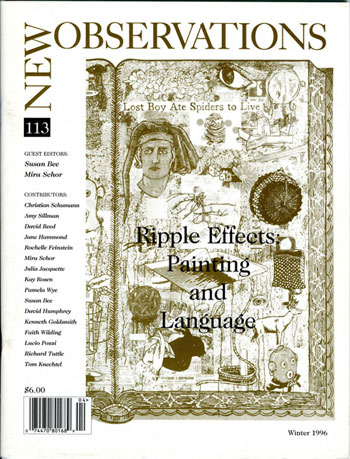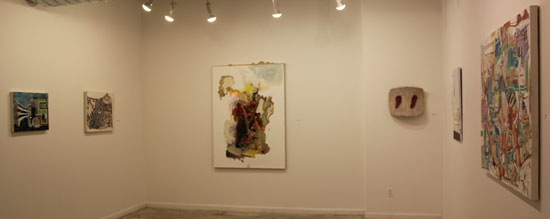POLIPOP, Mina Cheon at
Maryland Art Place, May 3 ‘12
Technology, Politics and Desire: A Mental Dialogue with Mina Cheon

“Polipop & Paintings” Mina Cheon’s representative artwork for the “Polipop & Paintings”
exhibition at the Maryland Art Place in 2012.
Irina Aristarkhova
Assistant Professor of Women’s Studies and Visual Art at Pennsylvania State University
I fully surrender to Mina Cheon’s ability to control the “poster aesthetic,” with its beautiful clarity and shamelessness of propaganda. Writing here, therefore, is not a form of resistance, but rather, of surrender. From Cheon one can learn the attraction of contemporary art, with its strategic use of materials (one uses what is necessary, rather than a default medium) and therefore, its puzzle. As an artist who employs a variety of resources at her disposal, from research and performance to new media and painting, Cheon complicates for me the idea of “good”: good ideology, good aesthetic, good technology, and good sexuality. By not representing too neatly the divisions between “evil ideology” and “evil technology” versus “good community” and “good humanity,” Cheon refuses the latent or obvious technophobia. The artist mixes women and machines with a precision of a surgeon. This nexus is not a simple embrace of technology, however. It is a strategy of joining forces between those who have been denied full humanity – women and machines. Once again, flipping the stereotypical images through spotlighting them, Cheon draws on their power to reinforce her own message. The two-three color background is identifiably militaristic and fetishistic, but at the same time, archaic in its appeal to an ethnic tradition and spirituality (fully red, fully green, etc.). The artist spices up her aesthetic with a healthy dose of gender politics, making her images almost unbearable in how closely they follow the canon of gender stereotypes. Women, flowers, tanks, missiles, dragons, larger than life faces of political leaders, gadgets, – this is the imagery of the new generation. The question that comes to mind, looking at these incredible works: “Do these images mean anything anymore?” Maybe, we are in a virtual reality game?
***
This work, seemingly loud and clear, requires silence and contemplation. Looking at them longer, I start feeling for Cheon’s characters. The empathy that her work evokes deconstructs the notions of simulacra and digital delirium. Empathizing with these works made me recollect how I observed Jean Baudrillard, the famous author of Simulacra and Simulation, and his wife on their visit to Seoul almost ten years ago. He was giving a talk at Ewha Woman’s University (part of the Media_City_Seoul Biennial, 2002, also where Cheon did her visiting professorship in 2011 as well as it being her alma mater). A high-tech country, as developed as France, but still feeling and being treated like an underdeveloped, as Cheon’s images demonstrate. The thinker seemed totally absorbed in himself, sitting alone on stage, reading his lecture on the topic of media and technology, without raising his head. A spotlight was on him, as if we were in a theatre, where one actor, the only actor, was reading his lines. A somber, dark, picture, of media and technology, which Baudrillard painted till the end. His wife sat in the front row, wearing high heels, elegant, tall (compared to those around her),and took many photographs with her small camera, directly shooting at our faces, pointing her camera into our faces, and looking as if being in wonder where she was. After the lecture ‘Korean girls’ (just like in Cheon’s posters? As well as those she is familiar with having gone to school in Seoul during various grades growing up whether they are actual girls or those who are imagined or projected) were screaming and asking for autographs as the Baudrillards passed by. They were photographing him at a close range, while his wife was photographing them photographing him. Baudrillard was performing ‘Pamela Anderson’ that evening, a star on a global circuit. Is there a difference, as far as the underlying aesthetic is concerned? This was, after all, the question raised in his own writings. Baudrillard looked intimidated, and probably, tired from the jetlag, shocked at the amount of technology and gadgets that people did not feel shy to use openly and a lot. Did he feel empathy? Cheon’s work, despite of being so direct and in my face, like those cameras, makes me co-feel, makes me feel compassion for her characters, who also often happen to be pop- or political stars. One can only wonder, what Baudrillard knew about South Korea before making that trip, and what kind of research he did about the country, the University, and those ‘Korean girls’ he came to speak to. As Cheon’s work also demonstrates, however, all those taken images could become one huge mess -a pile of representation, information, a confirmation of the evils of our mediated, twenty-four-seven, global simulacrum. And it is empathy for and politics of sexual, racial, and cultural differences, and not only technology of or desire for these differences that is so remarkable about Cheon’s representational choices.
***
Mina Cheon is also your typical superwoman: scholar, professor, mother, wife, artist, friend… Should I say more? Her contributions to the general area of new media art and theory are unique, evidenced by the book Shamanism + Cyberspace (2009). Cheon’s art is spellbinding. These art works are an injection of the most irresistible blend: ideology, aesthetics, technology, and sexuality. Born in the USSR, I am particularly susceptible to this blend, and I am not going to resist it. After all, I did assemble my toy MIGs (plastic models of Soviet supersonic jets) and proudly displayed them on my piano as a teenager. This global quality of “superwomanness” that Cheon represents for us here is, however, not what we usually think. As we grow out of our teenage years, we realize that the superwomanness is not about flying faster than the speed of light, or spinning ourselves to turn into cyborgs. With the full power and confidence of a superwoman, Cheon flips the technological into political. Or, as she demonstrates through an image of the existing sisterhood between a North Korean woman and a South Korean woman, the technological has never been a part of the superwomanness for a woman. Apparently, for a woman, to qualify as a superwoman in the 21st century, she has to spin, spin, spin, and then (one, two, three…), turn into being: “1. beautiful; 2. smart; 3. modest; 4. devoted wife; 5. bring income; 6. make babies; 7. educate self & children; 8. keep household; 9. book keeping; 10. good to in-laws; 11. take care of elders; 12. faithful to country and people; 13. know how to make kimchi from scratch; 14. good in bed while being a virgin” (as stated in Cheon’s Polipop digital painting Superwoman Complex). Nowhere here does it say “restoring justice around the world,” “inventing a time machine” or, at the very least, “assembling supersonic jets.” This image of sisterhood, between an icon of the communist state, portrayed in her stereotypical pop cultural fashion (the green “sexy” military uniform), and a middle class woman of capitalism, portrayed in a supposedly positive stereotypical image of the professional suit (of a flight attendant, or some other kind of business assistant, perhaps?), is laughable. This is where I salute Cheon’s ability to make me laugh, rather than become angry or sad. I cannot make kimchi from scratch, but surely, I can make a “real” Russian salad! What is our alternative, after all? Not to be modest (like “Pamela Anderson”?), not to be good to in-laws (like “Desperate Housewives”?), not to educate ourselves and our children (pick your own alternative to good education)? What Cheon is making us understand through this sisterly laughter, is that this list is so seductive because some parts of it are what we often want. As any good lie, it has elements of truth. This list is also powerful because becoming a ‘bad girl,’ the alter ego of the superwoman, is about following the same list, just in a reversed fashion: do not be this or that. Between a virgin and a prostitute: where is the space for my desire? Transnational dialogue here is necessary, where we can put our national flags aside and carefully examine what is at stake for us in all these lists. Mina Cheon’s work is a huge step in this direction. Cheon and Obama: We Can Do It. I LOVE IT.
Irina Aristarkhova writes and lectures on comparative feminist theory, new media aesthetics, and contemporary art. She is Assistant Professor of Women’s Studies and Visual Art at Pennsylvania State University, and Visiting Professor of Gender Studies at the department of Media Art History, Danube University at Krems (Austria). Her articles have been published in Body & Society; Theory, Culture & Society; Leonardo: Journal of Arts, Sciences and Technology; Performance Research Journal; Journal of Aesthetics & Culture, and Hypatia: A Journal of Feminist Philosophy. Her book Hospitality of the Matrix: Philosophy, Biomedicine, and Culture is forthcoming from Columbia University Press in 2012.
Links: Maryland Art Place

“Superwoman Complex” The superwoman complex for both South and North Korean woman follows
the Confucian law of the obedient Korean woman. Both are very common in that
they are brought up to please the nation, be subservient to the larger
patriarchal order, bear sons, and know how to cook kimchi from scratch – Mina Cheon

“How the USA Fell Off” The hourglass is turned on its side and what is falling
off the map is the land of the United States. This is how the U.S.A. fell off the planet,
indicating the new Asian (Chinese) century following the “American century.” – Mina Cheon

“Yes, We Can! Obama & Me” Standing back to back, this is a portrait of
Obama with his campaign slogan “Yes, We Can,” and the artist Mina Cheon with
“We Can Do It.” It appropriates the famous J. Howard Miller’s poster of Rosie the Riveter,
the icon of American women in factories during WWII

“Polipop & Paintings” Mina Cheon created this piece as the representative artwork for the
“Polipop & Paintings” exhibition at the Maryland Art Place in 2012. The background is an assemblage of
Tootsie lollipops wrapped in red and blue colors to signify the colors of the United States flag.
The one made for “Polipop” exhibition at the Sungkok Art Museum included yellow to portray
the Korean five colors of ohaeng. That piece is in the Sungkok Art Museum art collection.
“Polipop and Paintings” is in the Maryland Art Place art collection.
THE LANGUAGE OF PAINTING FINDS IT’S VOICE
April 2012 in New York
Mira Schor: VOICE AND SPEECH
at Marvelli Gallery in New York.

Mira Schor, Voice, 2010, Ink, oil, and gesso on linen, 12 x 16 inches Speech, 2010, Ink, oil
and gesso on linen, 12 x 16 inches
by Erika Knerr
The exhibition of Mira Schor’s new paintings Voice and Speech at Marvelli Gallery in New York is inspired by an idea in Michel de Certeau’s book of theory, The Practice of Everyday Life of pre-theoretical knowledge, the knowledge of the “folkloric, the body and of craft.” Schor is a painter with an ongoing relationship between theory and art practice. It is disorienting and sometimes places the user/viewer in an uncomfortable position of expecting one or the other, not both existing simultaneously. The discourse of hybrid art practice has attained acclaim, taking place where artists are working “in between” specializations especially where attention is paid to process, creating and organizing outside of the artist’s studio while engaging in a socio-political field.

Mira Schor, Silence, Noise, Speech, Voice, 2010, Ink, oil, and gesso on white linen, 18 x 30 inches
In her talk the week following her opening, at the “Conference: Art Practice, Activism, and Pedagogy: Some Feminist Views” at Parsons The New School for Design, Schor said, “The voice appears in the process of making the paintings. I am trying to speed up the relationship between reading, thinking, drawing and painting, very literally sketching myself in the act of reading and thinking….Voice and Speech are what I do …. bridging the gap between the voice of painting and the speech of Art Theory.” She spoke about her given ability to do both practices (painting and writing) and the impossibility of doing only one, because one informs the other. She sees herself “as a painter of language bridging the gap between two systems of knowledge.”

Mira Schor, Voice and Speech, 2010, Ink, oil, and gesso on white linen, 14 x 18 inches
The press text says the paintings are “philosophical meditations on the place of painting in contemporary culture, on the visual artist as a thinker, on painting as a uniquely sensual space for the visualization of thought itself.” The painting surface is intimate and sensually hand-made. There is a tension between the mark of the hand in a lush painterly space and the speech or words that are also painted. While viewing the paintings at the opening, I kept thinking about brainteasers I saw recently in a magazine, with experimentation showing the left and right hemispheres of the brain being responsible for different manners of thinking. There was some of this reconciliation going on here where the right brain was trying to view the color and seductiveness of “the touch” while the left brain was busy readying the words. There is an overt and intentional play between content and form, public and private.
They are thought portraits of the artist in the studio and in the world. An image of the figure/artist relating to herself and watching herself see the world. The artist is consciously viewing the world through the fabric of the self and then we see the thought coming out of the brain of the figure. During the feminism conference Schor spoke about Voice and Speech in relation to the Occupy Movement. While our freedoms of speech are gradually being stripped away, the Occupy movement is giving voice to the people waking up from a long paralysis. The metaphor of sleep and the collective dreaming of the protestors are used to engage with the idea of the dream of social change.

Mira Schor, The Dreams of All of Us, 2012, Ink, rabbit skin glue, oil, and gesso on linen, 24 x 28 inches

Mira Schor, Installation view, 2012
In 1996 Susan Bee and Mira Schor guest edited an issue of New Observations magazine titled, “Ripple Effects: Painting and Language. In this issue they invited some of the artists who were involved in M/E/A/N/I/N/G (an art journal they co-edited from 1986-1996) as well as others “whose art practice involves language and writing as either subject or image of their artwork or as a parallel practice, or significant source of inspiration”. There are contributions by Christian Schumann, Amy Sillman, David Reed, Jane Hammond, Rochelle Feinstein, Mira Schor, Julia Jacquette, Kay Rosen, Pamela Wye, Susan Bee, David Humphrey, Kenneth Goldsmith, Faith Wilding, Lucio Pozzi, Richard Tuttle, Tom Knechtel.

At the opening Emily Cheng introduced me to Roger Denson who wrote an in depth review of the work for the Huffington Post here. There is also a great interview with Mira Schor in two parts by Bradley Rubenstein. (Part One), (Part Two).
~Erika Knerr
Mira Schor is an American artist, writer, editor, and educator, known for her contributions to the critical discourse on the status of painting in contemporary art and culture as well as to feminist art history and criticism.
New Observations Magazine (http://newobs.org/backissues) was launched in New York City 1984 by the visual artist, Lucio Pozzi, with collectors Dorothy and Herbert Vogel. It was subsequently Trademarked under then President, Diane Karp, currently Executive Director – Santa Fe Art Institute, who has re-joined the Board of New Observations LTD. The magazine includes 128 back issues featuring many renowned visual artists speaking out as they emerged. The relaunch of the magazine was announced at the 2011 MoMA PS1 Art Book Fair and further announced at venues of PERFORMA11 in NYC through participating visual artists.
***

The Artist Curators, Weinberg (left) and Hackett (right)
Little Languages/Coded Pictures
Organized by artists Theresa Hackett and Michelle Weinberg
From Mira Schor’s opening I accompanied the artist/writer/palm reader Shelley Marlow to an open studio upstairs. Here among the rich painterly layers talking to me in Mary Jones Studio I learned of another exhibition exploring painting’s discourse called Little Languages/Coded Pictures. This is a two-gallery group exhibition organized by artists Theresa Hackett and Michelle Weinberg at Kathryn Markel Fine Arts in Chelsea and Lesley Heller Workspace on the Lower East Side. I asked the artists about the use of the two spaces and their experience organizing the shows.

Installation of Little Languages/Coded Pictures at Kathryn Markel Fine Art
In this era of mediated socializing, air kissing and other detached modes of interacting, it has been a real pleasure to connect with the artists in Little Languages/Coded Pictures. Each of them make profound, solitary investigations into the viscera and materia of painting, layering this work with meaning on many levels. Bringing their works together – and bringing them together in the openings – was very rewarding. Some of them are friends and colleagues for a long time, others I met at the opening for the first time! The beauty of collaborating with Theresa Hackett is that we were synchronized with each other, in an effortless, intuitive way. Our selections of artists and works was copesetic, and still the final product of their collective works caused a chemical reaction that surprised and delighted.
~Michelle Weinberg

Installation of Little Languages/Coded Pictures at Lesley Heller Workspce
The two differences in the shows is that at Kathy Markel there is more diverse work, such as works on paper, sculptural and 3 dimensional works. The work at Lesley Heller tends towards a tighter painting format. These shows are an extension of each other and we wanted a connection to Chelsea as well, so that the work was not all in one place. My interest and I think Michelle’s, is that there is some really good painting out there and over the years many of the artists in these shows have inspired or have connected with my (our) work in some way, it is like putting together your “Dream Team” of ideas.
~ Theresa Hackett

Theresa Hackett, Summer Trouble, 2011
Little Languages/Coded Pictures at Lesley Heller Workspace includes painters Mike Carroll, Alan Crockett, Julie Evans, Ron Gorchov, Theresa Hackett, Sharon Horvath, David Humphrey, Margrit Lewczuk, Laura Newman, Jennifer Reeves, David Storey and Michelle Weinberg.

Installation of Little Languages/Coded Pictures at Lesley Heller Workspce
Statement from both shows: A painter creates a lexicon. A glossolalia of marks, swerves of the brush, scrapes, dabs, drips. An anthology of the painter’s experience is translated into pigmented pastes of varying transparencies and densities. Application of these little languages to the surface of a painting, builds a story, intimate or epic. Of space and time, of the weight of gravity and slipping free from gravity. Pictorial space and logic is built of hermetic symbols created by the painter. One thing stands in for another. One gesture is surrogate for a single thing, or an entire range of experience. Learning to de-code the painting’s surface is part of the pleasure for the viewer. The curators selected works from artists in New York, Miami, Ohio, and from as far-flung as Helsinki. Their criteria was painterly abstractions that courted narrative, pictures that vibrated on the edge of being and representing, constructed of idiosyncratic painting languages.

Ron Gorchov, Thief of Bagdad, 2009

Theresa Hackett and Ron Gorchov at the opening of Little Languages/Coded Pictures
at Lesley Heller Workspce
And at Kathryn Markel Fine Arts the artists include Diane Ayott, Julie Davidow, Nancy Friedemann, Felice Grodin, Julie Gross, Theresa Hackett, Mary Jones, Sophy Naess, Marilla Palmer, Jennifer Sanchez, Yolanda Sanchez, Hal Saulson, Suzanne Ulrich, Kristiina Uusitalo, Chuck Webster, Michelle Weinberg, Charles Yuen.

Installation of Little Languages/Coded Pictures at Kathryn Markel Fine Art
~Erika Knerr
Michelle Weinberg creates works in painting and collage, designs rugs, tiles, mosaic and paint murals, and other surfaces for interiors, architecture and public spaces. She is the recipient of many awards and grants including MacDowell Colony, Fine Arts Work Center in Provincetown, South Florida Cultural Consortium Fellowship in Visual & Media Art, and a FIVA Fellowship from the National Foundation for Advancement in the Arts. She has exhibited work in Miami, New York, Provincetown and internationally. She is currently Adjunct Faculty and Miami International University of Art & Design. Weinberg has a BFA from School of Visual Arts and an MFA from Tyler School of Art and works in Miami Beach and New York City.
Theresa Hackett is a painter who was born in Los Angeles CA. She has had numerous one person and group exhibitions. Hackett is a recipient of a Pollock Krasner Grant, NYFA and various other grants, awards and residencies, including the Venice Printmaking Studio in 2011. She has a BFA from the University of California, Santa Barbara, College of Creative Studies, and an MFA from Hunter College NY. Hackett lives and work in New York City.


















